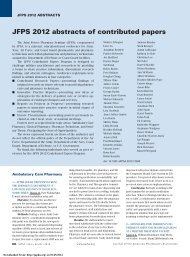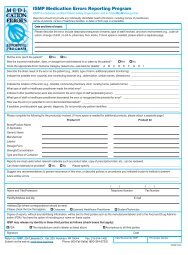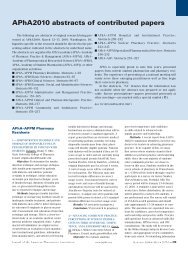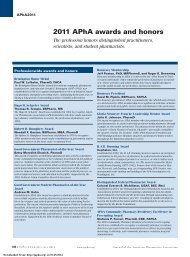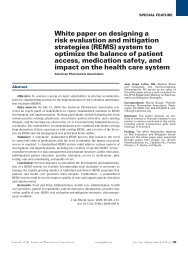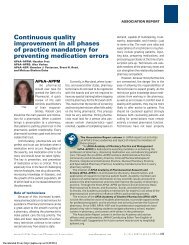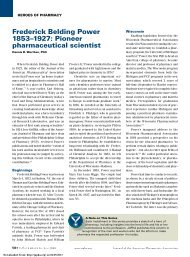Downloaded - Journal of American Pharmacists Association
Downloaded - Journal of American Pharmacists Association
Downloaded - Journal of American Pharmacists Association
You also want an ePaper? Increase the reach of your titles
YUMPU automatically turns print PDFs into web optimized ePapers that Google loves.
Annual Meeting Abstracts 2004<br />
FEATURE<br />
obtained includes demographics, web site availability<br />
and types <strong>of</strong> nonprescription medication inventories.<br />
A small panel <strong>of</strong> new pharmacy owners was interviewed<br />
for comments prior to the development <strong>of</strong> the<br />
pretest. Based on comments from the panel, drive<br />
through windows, friendly service and the availability<br />
<strong>of</strong> after-hours emergency medicine pickup were rated<br />
highly as important factors for success <strong>of</strong> the pharmacy.<br />
The survey was developed and pretested in<br />
approximately 10% <strong>of</strong> the population. The results <strong>of</strong><br />
the pretest were used to refine the survey.<br />
Results: The importance <strong>of</strong> specific programs and<br />
services in starting a new community pharmacy will<br />
be evaluated and described using Likert scale and<br />
frequency analysis.<br />
Conclusions: Will be reported upon completion<br />
<strong>of</strong> the project.<br />
4—DRUG BENEFIT MANAGEMENT<br />
STRATEGIES: CONSUMERS’ ATTITUDE AND<br />
PERCEPTIONS REGARDING FORMULA-<br />
RIES. Sikri S, Kawatkar A, Sansgiry S, University <strong>of</strong><br />
Houston. E-mail: ssikri@mail.uh.edu<br />
Objective: In recent years there has been a growing<br />
concern about the quality and cost <strong>of</strong> health care in<br />
America. Managed care has implemented drug benefits<br />
management strategies like formularies, which<br />
have evolved foremost amid cost containment strategies.<br />
However, most patients lack understanding <strong>of</strong><br />
these drug management strategies, which may lead to<br />
dissatisfaction. The objective <strong>of</strong> this study was to evaluate<br />
consumer perceptions regarding formularies and<br />
to understand their knowledge regarding formularies.<br />
Methods: A cross-sectional study was conducted<br />
by administering a survey to consumers (N = 714)<br />
waiting to pick a prescription in community pharmacies<br />
(N = 72) in the Houston metropolitan area. A<br />
prevalidated questionnaire using an 11-item, 5-point<br />
Likert scale (strongly disagree, 1; strongly agree, 5)<br />
was used to measure consumer perceptions and<br />
knowledge regarding drug formularies. Data along<br />
with demographic information such as age, gender,<br />
marital status, race, education and income were collected,<br />
coded, and analyzed using SAS at an a priori<br />
significance level <strong>of</strong> .05. Descriptive and correlation<br />
analyses were performed on the data.<br />
Results: Among the surveyed population, only<br />
25% <strong>of</strong> patients owned a copy <strong>of</strong> the formulary and<br />
75% had no knowledge that their prescription plan<br />
used the formularies. Majority <strong>of</strong> the respondents<br />
were white (43%), female (52%), married (52%), and<br />
working full-time (64%) with a mean age <strong>of</strong> 39.58 (±<br />
13.96) years. Overall, consumers had negative attitude<br />
towards formularies 2.77 (± 0.66). The respondents<br />
were neutral with respect to satisfaction with drugs<br />
included in their formulary 3.0 (±0.9). However analysis<br />
indicated that consumers were motivated to seek<br />
information regarding formularies 3.20 (± 0.98).<br />
Conclusions: Consumers had negative attitude<br />
toward formularies, which may be attributed to their<br />
lack <strong>of</strong> knowledge regarding formularies. Patient<br />
education efforts by health plan providers may help<br />
change consumer attitude and perception towards<br />
formularies.<br />
5—EVALUATION OF INSULIN<br />
GLARGINE USE IN MEDICAID PATIENT.<br />
Mohamed O, Bultemeier N, Yeah C, Oregon State<br />
University, College <strong>of</strong> Pharmacy. E-mail: mohamedo<br />
@ohsu.edu<br />
Objective: The objective <strong>of</strong> this study is to evaluate<br />
the increase in use <strong>of</strong> insulin glargine in the<br />
Oregon Medicaid fee-for-service population.<br />
Methods: Design: This is a retrospective study<br />
utilizing a prescription claim database and manual<br />
chart review. Setting: Office <strong>of</strong> Medical Assistance<br />
Programs (OMAP) prescription claim database and<br />
Oregon Health & Science University (OHSU) medical<br />
records will be used to identify subjects.<br />
Participants: Subjects 18 years and older with an<br />
insulin glargine claim during the 18-month period <strong>of</strong><br />
May 1, 2001 through October 31, 2002 and continuous<br />
eligibility 6 months prior to the claim will be eligible.<br />
Subjects receiving glargine from an OHSU<br />
prescriber and chronic diabetes care at OHSU will be<br />
identified to obtain clinical data. Subjects on chronic<br />
corticosteroid and/or immunosuppressant therapy<br />
and pregnant women will be excluded. Data collection:<br />
Diabetes medications before and after the sentinel<br />
glargine claim will be identified for all subjects.<br />
The following clinical data will be collected from<br />
chart review: weight, A1c, age, reasons for initiating<br />
and discontinuing glargine, type <strong>of</strong> diabetes, and prescriber’s<br />
specialty. All data will be de-identified.<br />
Analysis Plan: Descriptive statistics will be used to<br />
evaluate the characteristics <strong>of</strong> the sampled records.<br />
Furthermore, paired t-tests will be used to assess the<br />
change in A1c and weight at baseline versus 6-<br />
months and 12-months postsentinel claim.<br />
Results: Study findings will be presented.<br />
Conclusions: A conclusion will be presented<br />
based on study findings.<br />
6—EVALUATION OF MEDICATION NON-<br />
COMPLIANCE AT AN INDIAN HEALTH<br />
SERVICE HOSPITAL. Dupree M, Foster S,<br />
Dennewitz M, Cass Lake Indian Health Service<br />
Hospital. E-mail: michael.dupree@mail.ihs.gov<br />
Objective: The purpose <strong>of</strong> our retrospective evaluation<br />
was to assess improvement in medication<br />
compliance at an Indian Health Service Hospital<br />
with regard to patients picking up prescriptions.<br />
Methods: In October 2003, the Department <strong>of</strong><br />
Pharmacy installed an Interactive Voice Response<br />
(IVR) Application, Bin Management, Outbound<br />
Calling, and Status Inquiry Solution System to<br />
improve medication compliance and decrease the<br />
number <strong>of</strong> prescriptions that were being returned to<br />
stock. Through retrospective review, prescriptions<br />
unclaimed by patients for a 10-month period from 1<br />
April 2003 to 31 Jan 2004 were analyzed. Pharmacy<br />
staff used the weekly return to stock medication<br />
labels and bin management return to stock reports<br />
before and after IVR installation. To determine<br />
which prescriptions were never dispensed, system<br />
reports were used for medication utilization review<br />
for data categorization and tracking purposes.<br />
Unclaimed prescriptions were tracked according to<br />
the following criteria: (1) Prevalence based on individual<br />
drug therapeutic classification; (2) total number<br />
<strong>of</strong> unclaimed prescriptions compared with the<br />
total number <strong>of</strong> patients with unclaimed prescriptions<br />
(some patients had multiple prescriptions); and<br />
(3) total number <strong>of</strong> unclaimed prescriptions compared<br />
with the total number <strong>of</strong> prescriptions filled<br />
during the tracking period.<br />
Results: Data collection ongoing,<br />
Conclusions: NA.<br />
7—MEDMARX: A MEDICATION ANALY-<br />
SIS TOOL FOR THE 21ST CENTURY, OR<br />
TEACHING AN OLD DOG NEW TRICKS.<br />
Shalita E, Guill J, United States Air Force, Rogers L,<br />
University <strong>of</strong> the Sciences in Philadelphia. E-mail:<br />
julie.guill@mcguire.af.mil<br />
Objective: Medication error analysis has become<br />
a mainstay <strong>of</strong> administrative pharmacy practice.<br />
Tying medication errors to breakdowns in process<br />
has been an emphasis since the early 1990s. Various<br />
methods have been used to determine the root causes<br />
<strong>of</strong> medication errors, leading to process improvement.<br />
Some <strong>of</strong> these methods include electronic<br />
spreadsheets, manual paper trail, AF form 765,<br />
CRAF documentation, and home-grown databases.<br />
A new tool, MedMarx was installed at McGuire Air<br />
Force Base (AFB), N.J., in December 2002. This<br />
program will examine the utility <strong>of</strong> this tool in root<br />
cause analysis <strong>of</strong> medication errors.<br />
Methods: McGuire AFB Pharmacy conducted<br />
two retrospective error analyses using 18 months <strong>of</strong><br />
data.<br />
Results: Error analysis tied greatest risk to a single<br />
process step and identified new targets for opportunity.<br />
Conclusions: MEDMARX provides standardized<br />
tools for evaluating errors in an objective manner.<br />
Data can be analyzed using a concise reporting format<br />
and a standard definition <strong>of</strong> errors. Meaningful<br />
reports and charts present data in a way that clearly<br />
and easily identifies trends so that it can be acted<br />
upon to make valuable process improvements.<br />
8—OVER-THE-COUNTER MEDICATION<br />
LABELS FOR BLIND CONSUMERS. Pawaskar<br />
M, Sansgiry S, University <strong>of</strong> Houston. E-mail:<br />
p_manj@rediffmail.com<br />
Objective: To develop and evaluate the use <strong>of</strong><br />
Braille and large print, over-the-counter (OTC) medication<br />
labels for blind and visually impaired consumers.<br />
Methods: The project is divided into three phases:<br />
development, implementation, and evaluation. In<br />
the first phase, OTC medication labels <strong>of</strong> analgesics<br />
will be developed in Braille for totally blind consumers.<br />
The study will also develop large print (18-<br />
font size) labels especially for visually impaired consumers.<br />
In implementation phase, these labels will<br />
be tested in 50 blind and 50 visually impaired consumers.<br />
Participants will be chosen randomly from<br />
organizations and institutes that provide services and<br />
education for blind and visually impaired population.<br />
An experimental study design will be conducted<br />
to assess the effectiveness <strong>of</strong> such labels to help<br />
blind consumers comprehend OTC medication<br />
2004 Abstracts <strong>of</strong> Contributed Papers<br />
Vol. 44, No. 2 March/April 2004 www.japha.org <strong>Journal</strong> <strong>of</strong> the <strong>American</strong> <strong>Pharmacists</strong> <strong>Association</strong> 227<br />
<strong>Downloaded</strong> From: http://japha.org/ on 01/25/2014



